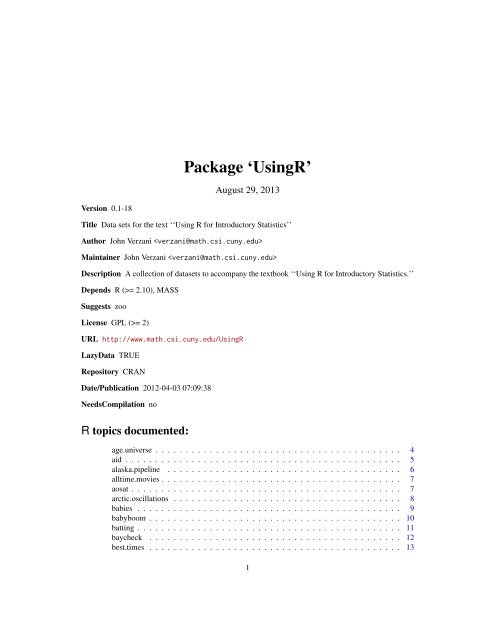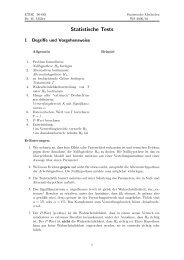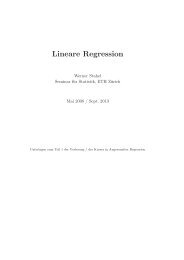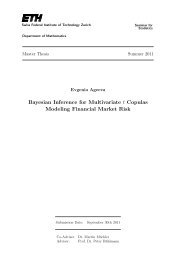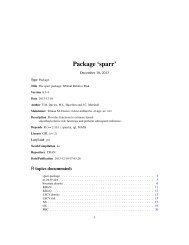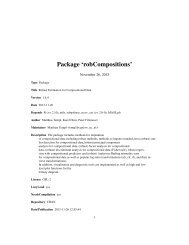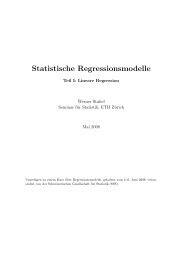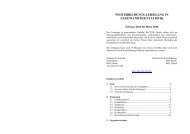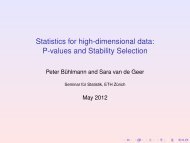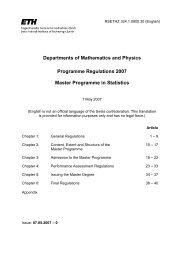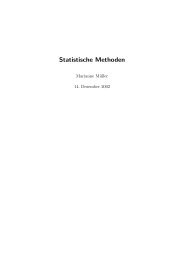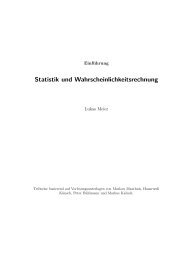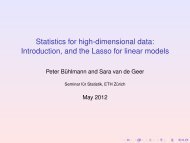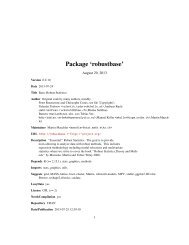Package 'UsingR' - The Comprehensive R Archive Network
Package 'UsingR' - The Comprehensive R Archive Network
Package 'UsingR' - The Comprehensive R Archive Network
Create successful ePaper yourself
Turn your PDF publications into a flip-book with our unique Google optimized e-Paper software.
R topics documented: 3grip . . . . . . . . . . . . . . . . . . . . . . . . . . . . . . . . . . . . . . . . . . . . . 50hall.fame . . . . . . . . . . . . . . . . . . . . . . . . . . . . . . . . . . . . . . . . . . 51healthy . . . . . . . . . . . . . . . . . . . . . . . . . . . . . . . . . . . . . . . . . . . . 52heartrate . . . . . . . . . . . . . . . . . . . . . . . . . . . . . . . . . . . . . . . . . . . 53home . . . . . . . . . . . . . . . . . . . . . . . . . . . . . . . . . . . . . . . . . . . . 54homedata . . . . . . . . . . . . . . . . . . . . . . . . . . . . . . . . . . . . . . . . . . 54homeprice . . . . . . . . . . . . . . . . . . . . . . . . . . . . . . . . . . . . . . . . . . 55homework . . . . . . . . . . . . . . . . . . . . . . . . . . . . . . . . . . . . . . . . . . 56HUMMER . . . . . . . . . . . . . . . . . . . . . . . . . . . . . . . . . . . . . . . . . 56iq . . . . . . . . . . . . . . . . . . . . . . . . . . . . . . . . . . . . . . . . . . . . . . 57kid.weights . . . . . . . . . . . . . . . . . . . . . . . . . . . . . . . . . . . . . . . . . 58KSI . . . . . . . . . . . . . . . . . . . . . . . . . . . . . . . . . . . . . . . . . . . . . 59last.tie . . . . . . . . . . . . . . . . . . . . . . . . . . . . . . . . . . . . . . . . . . . . 59lawsuits . . . . . . . . . . . . . . . . . . . . . . . . . . . . . . . . . . . . . . . . . . . 60malpract . . . . . . . . . . . . . . . . . . . . . . . . . . . . . . . . . . . . . . . . . . . 61mandms . . . . . . . . . . . . . . . . . . . . . . . . . . . . . . . . . . . . . . . . . . . 61math . . . . . . . . . . . . . . . . . . . . . . . . . . . . . . . . . . . . . . . . . . . . . 62maydow . . . . . . . . . . . . . . . . . . . . . . . . . . . . . . . . . . . . . . . . . . . 63midsize . . . . . . . . . . . . . . . . . . . . . . . . . . . . . . . . . . . . . . . . . . . 64MLBattend . . . . . . . . . . . . . . . . . . . . . . . . . . . . . . . . . . . . . . . . . 64movies . . . . . . . . . . . . . . . . . . . . . . . . . . . . . . . . . . . . . . . . . . . . 65mw.ages . . . . . . . . . . . . . . . . . . . . . . . . . . . . . . . . . . . . . . . . . . . 66nba.draft . . . . . . . . . . . . . . . . . . . . . . . . . . . . . . . . . . . . . . . . . . . 67normtemp . . . . . . . . . . . . . . . . . . . . . . . . . . . . . . . . . . . . . . . . . . 67npdb . . . . . . . . . . . . . . . . . . . . . . . . . . . . . . . . . . . . . . . . . . . . . 68nym.2002 . . . . . . . . . . . . . . . . . . . . . . . . . . . . . . . . . . . . . . . . . . 70OBP . . . . . . . . . . . . . . . . . . . . . . . . . . . . . . . . . . . . . . . . . . . . . 71oral.lesion . . . . . . . . . . . . . . . . . . . . . . . . . . . . . . . . . . . . . . . . . . 71ozonemonthly . . . . . . . . . . . . . . . . . . . . . . . . . . . . . . . . . . . . . . . . 72paradise . . . . . . . . . . . . . . . . . . . . . . . . . . . . . . . . . . . . . . . . . . . 73pi2000 . . . . . . . . . . . . . . . . . . . . . . . . . . . . . . . . . . . . . . . . . . . . 73primes . . . . . . . . . . . . . . . . . . . . . . . . . . . . . . . . . . . . . . . . . . . . 74puerto . . . . . . . . . . . . . . . . . . . . . . . . . . . . . . . . . . . . . . . . . . . . 74QQplot . . . . . . . . . . . . . . . . . . . . . . . . . . . . . . . . . . . . . . . . . . . 75rat . . . . . . . . . . . . . . . . . . . . . . . . . . . . . . . . . . . . . . . . . . . . . . 76reaction.time . . . . . . . . . . . . . . . . . . . . . . . . . . . . . . . . . . . . . . . . 77reddrum . . . . . . . . . . . . . . . . . . . . . . . . . . . . . . . . . . . . . . . . . . . 78salmon.rate . . . . . . . . . . . . . . . . . . . . . . . . . . . . . . . . . . . . . . . . . 78salmonharvest . . . . . . . . . . . . . . . . . . . . . . . . . . . . . . . . . . . . . . . . 79samhda . . . . . . . . . . . . . . . . . . . . . . . . . . . . . . . . . . . . . . . . . . . 80scatter.with.hist . . . . . . . . . . . . . . . . . . . . . . . . . . . . . . . . . . . . . . . 81scrabble . . . . . . . . . . . . . . . . . . . . . . . . . . . . . . . . . . . . . . . . . . . 82sim . . . . . . . . . . . . . . . . . . . . . . . . . . . . . . . . . . . . . . . . . . . . . . 83simple.chutes . . . . . . . . . . . . . . . . . . . . . . . . . . . . . . . . . . . . . . . . 83simple.densityplot . . . . . . . . . . . . . . . . . . . . . . . . . . . . . . . . . . . . . . 84simple.eda . . . . . . . . . . . . . . . . . . . . . . . . . . . . . . . . . . . . . . . . . . 85simple.eda.ts . . . . . . . . . . . . . . . . . . . . . . . . . . . . . . . . . . . . . . . . 86simple.fancy.stripchart . . . . . . . . . . . . . . . . . . . . . . . . . . . . . . . . . . . 87
aid 5FormatDetailsA data frame with 15 observations on the following 4 variables.lower a numeric vectorupper a numeric vectoryear a numeric vectorsource Short description of sourceIn the last two decades estimates for the age of the universe have been greatly improved. As of2003, the best guess is 13.7 billion years with a margin of error of 1 percent. This last estimate isfound by WMAP using microwave background radiation. Previous estimates were also based onestimates of Hubble’s constant, and dating of old stars.SourceThis data was collected from the following web sites: http://www.cwru.edu/pubaff/univcomm/2003/1-03/kraussuniverse.htm, http://www.astro.ucla.edu/~wright/age.html, http://www.lhup.edu/~dsimanek/cutting/ageuniv.htm, and http://map.gsfc.nasa.gov/m_uni/uni_101age.html.Examplesdata(age.universe)n = nrow(age.universe)x = 1:15;names(x) = age.universe$yearplot(x,age.universe$upper,ylim=c(0,20))points(x,age.universe$lower)with(age.universe,sapply(x,function(i) lines(c(i,i),c(lower[i],upper[i]))))aidmonthly payment for federal programDescriptionmonthly payment for federal programUsagedata(aid)Format<strong>The</strong> format is: Named num [1:51] 57.2 253.5 114.2 68.2 199.6 ... - attr(*, "names")= chr [1:51]"Alabama" "Alaska" "Arizona" "Arkansas" ...
6 alaska.pipelineSourceFrom Kitchen’s Exploring StatisticsExamplesdata(aid)hist(aid)alaska.pipelineComparison of in-field and laboratory measurement of defectsDescription<strong>The</strong> Alaska pipeline data consists of in-field ultrasonic measurements of the depths of defects inthe Alaska pipeline. <strong>The</strong> depth of the defects were then re-measured in the laboratory. <strong>The</strong>semeasurements were performed in six different batches.Usagedata(alaska.pipeline)FormatA data frame with 107 observations on the following 3 variables.field.defect Depth of defect as measured in fieldlab.defect Depth of defect as measured in labbatch One of 6 batchesSourceFrom an example in Engineering Statistics Handbook from http://www.itl.nist.gov/div898/handbook/Examplesdata(alaska.pipeline)res = lm(lab.defect ~ field.defect, alaska.pipeline)plot(lab.defect ~ field.defect, alaska.pipeline)abline(res)plot(fitted(res),resid(res))
alltime.movies 7alltime.moviesTop movies of all timeDescriptionUsageFormatSource<strong>The</strong> top 79 all-time movies as of 2003 by domestic (US) gross receipts.data(alltime.movies)A data frame with 79 observations on the following 2 variables.Gross a numeric vectorRelease.Year a numeric vector<strong>The</strong> row names are the titles of the movies.This data was found on http://movieweb.com/movie/alltime.html on June 17, 2003. <strong>The</strong>source of the data is attributed to (partially) Exhibitor Relations Co. .Examplesdata(alltime.movies)hist(alltime.movies$Gross)aosatArtic Oscillation data based on SAT dataDescriptionUsageFormatA time series of January, February, and March measurements of the annular modes from January1851 to March 1997.data(aosat)<strong>The</strong> format is: first column is date in years with fraction to indicate month. <strong>The</strong> second column isthe measurement.
8 arctic.oscillationsDetailsSee http://jisao.washington.edu/ao/ for more details on the importance of this time series.SourceThis data came from the file AO\_SATindex\_JFM\_Jan1851March1997.ascii at http://www.atmos.colostate.edu/ao/Data/ao_index.htmlExamplesdata(aosat)## Not run:library(zoo)z = zoo(aosat[,2], order.by=aosat[,1])plot(z)## yearlyplot(aggregate(z, floor(index(z)), mean))## decade-long meansplot(aggregate(z, 10*floor(index(z)/10), mean))## End(Not run)arctic.oscillationsMeasurement of sea-level pressure at the arcticDescriptionA monthly time series from January 1899 to June 2002 of sea-level pressure measurements relativeto some baseline.Usagedata(arctic.oscillations)Format<strong>The</strong> format is: chr "arctic.oscillations"DetailsSee http://jisao.washington.edu/ao/ for more details on the importance of this time series.Source<strong>The</strong> data came from the file AO\_TREN\_NCEP\_Jan1899Current.ascii found at http://www.atmos.colostate.edu/ao/Data/ao_index.html.
abies 9Examplesdata(arctic.oscillations)x = ts(arctic.oscillations, start=c(1899,1), frequency=12)plot(x)babiesMothers and their babies dataDescriptionUsageFormatA collection of variables taken for each new mother in a Child and Health Development Study.data(babies)A data frame with 1,236 observations on the following 23 variables.Variables in data fileid identification numberpluralty 5= single fetusoutcome 1= live birth that survived at least 28 daysdate birth date where 1096=January1,1961gestation length of gestation in dayssex infant’s sex 1=male 2=female 9=unknownwt birth weight in ounces (999 unknown)parity total number of previous pregnancies including fetal deaths and still births, 99=unknownrace mother’s race 0-5=white 6=mex 7=black 8=asian 9=mixed 99=unknownage mother’s age in years at termination of pregnancy, 99=unknowned mother’s education 0= less than 8th grade, 1 = 8th -12th grade - did not graduate, 2= HSgraduate–no other schooling , 3= HS+trade, 4=HS+some college 5= College graduate, 6\&7Trade school HS unclear, 9=unknownht mother’s height in inches to the last completed inch 99=unknownwt1 mother prepregnancy wt in pounds, 999=unknowndrace father’s race, coding same as mother’s race.dage father’s age, coding same as mother’s age.dedfather’s education, coding same as mother’s education.dht father’s height, coding same as for mother’s heightdwtfather’s weight coding same as for mother’s weightmarital 1=married, 2= legally separated, 3= divorced, 4=widowed, 5=never married
10 babyboominc family yearly income in \$2500 increments 0 = under 2500, 1=2500-4999, ..., 8= 12,500-14,999, 9=15000+, 98=unknown, 99=not askedsmoke does mother smoke? 0=never, 1= smokes now, 2=until current pregnancy, 3=once did, notnow, 9=unknowntime If mother quit, how long ago? 0=never smoked, 1=still smokes, 2=during current preg,3=within 1 yr, 4= 1 to 2 years ago, 5= 2 to 3 yr ago, 6= 3 to 4 yrs ago, 7=5 to 9yrs ago,8=10+yrs ago, 9=quit and don’t know, 98=unknown, 99=not askednumber number of cigs smoked per day for past and current smokers 0=never, 1=1-4,2=5-9, 3=10-14, 4=15-19, 5=20-29, 6=30-39, 7=40-60, 8=60+, 9=smoke but don’t know,98=unknown,99=not askedSourceThis dataset is found from http://www.stat.berkeley.edu/users/statlabs/labs.html. Itaccompanies the excellent text Stat Labs: Mathematical Statistics through Applications Springer-Verlag (2001) by Deborah Nolan and Terry Speed.Examplesdata(babies)plot(wt ~ factor(smoke), data=babies)plot(wt1 ~ dwt, data=babies, subset=wt1 < 800 & dwt < 800)babyboomBabyboom: data for 44 babies born in one 24-hour period.Description<strong>The</strong> babyboom dataset contains the time of birth, sex, and birth weight for 44 babies born in one24-hour period at a hospital in Brisbane, Australia.Usagedata(babyboom)FormatA data frame with 44 observations on the following 4 variables.clock.time Time on clockgender a factor with levels girl boywt weight in grams of childrunning.time minutes after midnight of birth
atting 11SourceThis data set was submitted to the Journal of Statistical Education, http://www.amstat.org/publications/jse/secure/v7n3/datasets.dunn.cfm, by Peter K. Dunn.Examplesdata(babyboom)hist(babyboom$wt)hist(diff(babyboom$running.time))battingBatting statistics for 2002 baseball seasonDescriptionUsageFormatThis dataset contains batting statistics for the 2002 baseball season. <strong>The</strong> data allows you to computebatting averages, on base percentages, and other statistics of interest to baseball fans. <strong>The</strong> data onlycontains players with more than 100 atbats for a team in the year. <strong>The</strong> data is excerpted withpermission from the Lahman baseball database at http://www.baseball1.com/.data(batting)A data frame with 438 observations on the following 22 variables.playerID This is coded, but those familiar with the players should be able to find their favorites.yearID a numeric vector. Always 2002 in this dataset.stintID a numeric vector. Player’s stint (order of appearances within a season)teamID a factor with TeamlgID a factor with levels AL NLG number of games playedAB number of at batsR number of runsH number of hitsDOUBLE number of doubles. "2B" in original dat a base.TRIPLE number of triples. "3B" in original data baseHR number of home runsRBI number of runs batted inSB number of stolen basesCS number of times caught stealing
12 baycheckBB number of base on balls (walks)SO number of strikeoutsIBB number of intentional walksHBP number of hit by pitchesSH number of sacrifice hitsSF number of sacrifice fliesGIDP number of grounded into double playsDetailsBaseball fans are “statistics” crazy. <strong>The</strong>y love to talk about things like RBIs, BAs and OBPs. Inorder to do so, they need the numbers. This data comes from the Lahman baseball database athttp://www.baseball1.com/. <strong>The</strong> complete dataset includes data for all of baseball not just theyear 2002 presented here.SourceLahman baseball database, http://www.baseball1.com/ReferencesIn addition to the data set above, the book Curve Ball, by Albert, J. and Bennett, J., CopernicusBooks, gives an extensive statistical analysis of baseball.See http://www.baseball-almanac.com/stats.shtml for definitions of common baseball statistics.Examplesdata(batting)attach(batting)BA = H/AB # batting averageOBP = (H + BB + HBP) / (AB + BB + HBP + SF) # On base "percentage"baycheckPopulation estimate of type of Bay Checkerspot butterflyDescriptionEstimates of the population of a type of Bay Checkerspot butterfly near San Francisco.Usagedata(baycheck)
est.times 13FormatSourceA data frame with 27 observations on the following 2 variables.year a numeric vectorNt estimated numberFrom chapter 4 of Morris and Doak, Quantitative Conservation Biology: <strong>The</strong>ory and Practice ofPopulation Viability Analysis, Sinauer Associates, 2003.Examplesdata(baycheck)plot(Nt ~ year,baycheck)## fit Ricker model N_{t+1} = N_t e^{-rt}W_tn = length(baycheck$year)yt = with(baycheck,log(Nt[-1]/Nt[-n]))nt = with(baycheck,Nt[-n])lm(yt ~ nt,baycheck)best.timesBest track and field times by age and distanceDescriptionA dataset giving world records in track and field running events for various distances and differentage groups.Usagedata(best.times)FormatDetailsA data frame with 113 observations on the following 6 variables.Dist Distance in meters (42195 is a marathon)Name Name of record holderDate Date of recordTime Time in secondsTime.1 Time as characterage Age at time of recordAge-graded race results allow competitors of different ages to compare their race performances.This data set allows one to see what the relationship is based on peak performances.
14 bloodSource<strong>The</strong> data comes from http://www.personal.rdg.ac.uk/~snsgrubb/athletics/agegroups.htmlwhich includes a calculator to compare results.Examplesdata(best.times)attach(best.times)by.dist = split(best.times,as.factor(Dist))lm(scale(Time) ~ age, by.dist[[’400’]])dists = names(by.dist)lapply(dists, function(n) print(lm(scale(Time) ~ age, by.dist[[n]])))bloodblood pressure readingsDescriptionblood pressure of 15 males taken by machine and expertUsagedata(blood)FormatThis data frame contains the following columns:Machine a numeric vectorExpert a numeric vectorSourceTaken from Kitchen’s Exploring Statistics.References~~ possibly secondary sources and usages ~~Examplesdata(blood)attach(blood)t.test(Machine,Expert)detach(blood)
eakdown 15breakdownTime of insulating fluid to breakdownDescription<strong>The</strong> time in minutes for an insulating fluid to break down under varying voltage loadsUsagedata(breakdown)FormatA data frame with 75 observations on the following 2 variables.voltage Number of kVtime time in minutesDetailsAn example from industry where a linear model is used with replication and transformation ofvariables.SourceData is from Display 8.3 of Ramsay and Shafer, <strong>The</strong> Statistical Sleuth Duxbury Press, 1997.Examplesdata(breakdown)plot(log(time) ~ voltage, data = breakdown)bright.starsList of bright stars with Hipparcos catalog numberDescriptionList of bright stars with Hipparcos catalog number.Usagedata(bright.stars)
16 brightnessFormatDetailsSourceA data frame with 96 observations on the following 2 variables.name Common name of starhip HIP number for identification<strong>The</strong> source of star names goes back to the Greeks and Arabs. Few are modern. This is a list of 96common stars.Form the Hipparcos website http://astro.estec.esa.nl/Hipparcos/ident6.html.Examplesdata(bright.stars)all.names = paste(bright.stars$name, sep="", collapse="")x = unlist(strsplit(tolower(all.names), ""))letter.dist = sapply(letters, function(i) sum(x == i))data(scrabble) # for frequency infop = scrabble$frequency[1:26];p=p/sum(p)chisq.test(letter.dist, p=p) # compare with EnglishbrightnessBrightness of 966 starsDescriptionUsageFormatDetailsSource<strong>The</strong> Hipparcos Catalogue has information on over 100,000 stars. Listed in this dataset are brightnessmeasurements for 966 stars from a given sector of the sky.data(brightness)A univariate dataset of 966 numbers.This is field H5 in the catalog measuring the magnitude, V , in the Johnson UBV photometricsystem. <strong>The</strong> smaller numbers are for brighter stars.http://astro.estec.esa.nl/hipparcos
cancer 21DetailsThis series is a standard example for the concept of long memory time series.<strong>The</strong> data was produced and assembled at the Tree Ring Laboratory at the University of Arizona,Tuscon.SourceTime Series Data Library:http://www-personal.buseco.monash.edu.au/~hyndman/TSDL/ReferencesThis data set is in the tseries package. It is repackaged here for convenience only.Examplesdata(camp)acf(camp)cancercancer survival timesDescriptioncancer survival timesUsagedata(cancer)Format<strong>The</strong> format is: <strong>The</strong> format is: List of 5 numeric components stomach, bronchus, colon, ovary andbreastSourceTaken from L. Kitchens, Exploring Statistics, Duxbury Press, 1997.Examplesdata(cancer)boxplot(cancer)
22 carsafetycarbonCarbon Monoxide levels at different sitesDescriptionCarbon Monoxide levels at different sitesUsagedata(carbon)FormatThis data frame contains the following columns:Monoxide a numeric vectorSite a numeric vectorSourceBorrowed from Kitchen’s Exploring StatisticsExamplesdata(carbon)boxplot(Monoxide ~ Site,data=carbon)carsafetyFatality information in U.S. for several popular carsDescriptionSafety statistics appearing in a January 12th, 2004 issue of the New Yorker showing fatality ratesper million vehicles both for drivers of a car, and drivers of other cars that are hit.Usagedata(carsafety)FormatA data frame with 33 observations on the following 4 variables.Make.model <strong>The</strong> make and model of the cartype Type of carDriver.deaths Number of drivers deaths per year if 1,000,000 cars were on the roadOther.deaths Number of deaths in other vehicle caused by accidents involving these cars per yearif 1,000,000 cars were on the road
central.park 23DetailsSource<strong>The</strong> article this data came from wishes to make the case that SUVs are not safer despite a perceptionamong the U.S. public that they are.From "Big and Bad" by Malcolm Gladwell. New Yorker, Jan. 12 2004 pp28-33. Data attributed toTom Wenzel and Marc Ross who have written http://www.lbl.gov/Science-Articles/<strong>Archive</strong>/assets/images/2002/Aug-26-2002/SUV-report.pdf.Examplesdata(carsafety)plot(Driver.deaths + Other.deaths ~ type, data = carsafety)plot(Driver.deaths + Other.deaths ~ type, data = carsafety)central.park Weather in Central Park NY in May 2003DescriptionUsageFormatA listing of various weather measurements made at Central Park in New York City during the monthof May 2003.data(central.park)A data frame with 31 observations on the following 19 variables.DY the dayMAX maximum temperature (temperatures in Farenheit)MIN minimum temperatureAVG average temperatureDEP departure from normalHDD heating degree daysCDD cooling degree daysWTR Water fall. A factor as "T" is a trace.SNW Amount of snowfallDPTH Depth of snowSPD Average wind speedSPD1 Max wind speed
24 central.park.cloudDetailsSourceDIR 2 minimum directionMIN2 Sunshine measurement a factor with two levels 0 MPSBL Sunshine measurement a factor with levels 0 MS.S Sunshine measurement. 0-3 = Clear, 4-7 partly cloudy, 8-10 is cloudyWX (This is not as documented in the data source. Ignore this variable. It should be: 1 = FOG, 2 =FOG REDUCING VISIBILITY TO 1/4 MILE OR LESS, 3 = THUNDER, 4 = ICE PELLETS,5 = HAIL, 6 = GLAZE OR RIME, 7 = BLOWING DUST OR SAND: VSBY 1/2 MILE ORLESS, 8 = SMOKE OR HAZE, 9 = BLOWING SNOW, X = TORNADO)SPD3 peak wind speedDR direction of peak windThis datasets summarizes the weather in New York City during the merry month of May 2003. Thisdata set comes from the daily climate report issued by the National Weather Service Office.This data is published by http://www.noah.gov.Examplesdata(central.park)attach(central.park)barplot(rbind(MIN,MAX-MIN),ylim=c(0,80))central.park.cloud Type of day in Central Park, NY May 2003DescriptionUsageFormatSource<strong>The</strong> type of day in May 2003 in Central Park, NYdata(central.park.cloud)A factor with levels clear,partly.cloudy and cloudy.This type of data, and much more, is available from http://www.noaa.gov.Examplesdata(central.park.cloud)table(central.park.cloud)
cfb 25cfbBootstrap sample from the Survey of Consumer FinancesDescriptionA bootstrap sample from the “Survey of Consumer Finances”.Usagedata(cfb)FormatA data frame with 1000 observations on the following 14 variables.WGT Weights to comensate for undersampling. Not applicableAGE Age of participantsEDUC Education level (number of years) of participantINCOME Income in year 2001 of participantCHECKING Amount in checking account for participantSAVING Amount in savings accountsNMMF Total directly-held mutual fundsSTOCKS Amount held in stocksFIN Total financial assetsVEHIC Value of all vehicles (includes autos, motor homes, RVs, airplanes, boats)HOMEEQ Total home equityOTHNFIN Other financial assetsDEBT Total debtNETWORTH Total net worthDetails<strong>The</strong> SCF dataset is a comprehensive survey of consumer finances sponsored by the United StatesFederal Reserve, http://www.federalreserve.gov/pubs/oss/oss2/2001/scf2001home.html.<strong>The</strong> data is oversampled to compensate for low response in the upper brackets. To compensate,weights are assigned. By bootstrapping the data with the weights, we get a “better” version of arandom sample from the population.Sourcehttp://www.federalreserve.gov/pubs/oss/oss2/2001/scf2001home.html
26 chipsExamplesdata(cfb)attach(cfb)mean(INCOME)chickenweight gain of chickens fed 3 different rationsDescriptionweight gain of chickens fed 3 different rationsUsagedata(chicken)FormatThis data frame contains the following columns:Ration1 a numeric vectorRation2 a numeric vectorRation3 a numeric vectorSourceFrom Kitchens’ Exploring Statistics.Examplesdata(chicken)boxplot(chicken)chipsMeasurements of chip wafersDescription<strong>The</strong> chips data frame has 30 rows and 8 columns.Usagedata(chips)
co2emiss 27FormatSourceThis data frame contains the following columns:wafer11 a numeric vectorwafer12 a numeric vectorwafer13 a numeric vectorwafer14 a numeric vectorwafer21 a numeric vectorwafer22 a numeric vectorwafer23 a numeric vectorwafer24 a numeric vectorFrom Kitchens’ Exploring StatisticsExamplesdata(chips)boxplot(chips)co2emissCarbon Dioxide Emissions from the U.S.A. from fossil fuelDescriptionUsageFormatDetailsCarbon Dioxide Emissions from the U.S.A. from fossil fueldata(co2emiss)<strong>The</strong> format is: Time-Series [1:276] from 1981 to 2004: -30.5 -30.4 -30.3 -29.8 -29.6 ...Monthly estimates of 13C/12C in fossil-fuel CO2 emissions. For write up see http://cdiac.esd.ornl.gov/trends/emis_mon/emis_mon_co2.html. In particular find:"An annual cycle, peaking during the winter months and reflecting natural gas consumption, anda semi-annual cycle of lesser amplitude, peaking in summer and winter and reflecting coal consumption,comprise the dominant features of the annual pattern. <strong>The</strong> relatively constant emissionsuntil 1987, followed by an increase from 1987-1989, a decrease in 1990-1991 and record highsduring the late 1990s, are also evident in the annual data of Marland et al. However, emissions havedeclined somewhat since 2000."
28 coldvermontSourcehttp://cdiac.esd.ornl.gov/ftp/trends/emis_mon/emis_mon_c13.datExamplesdata(co2emiss)monthplot(co2emiss)stl(co2emiss, s.window="periodic")coins<strong>The</strong> coins in my change binDescriptionUsageFormat<strong>The</strong> coins in author’s change bin with year and value.data(coins)A data frame with 371 observations on the following 2 variables.year Year of coinvalue Value of coin: quarter, dime, nickel, or pennyExamplesdata(coins)years = cut(coins$year,seq(1920,2010,by=10),include.lowest=TRUE,labels = paste(192:200,"*",sep=""))table(years)coldvermontDaily minimum temperature in Woodstock VermontDescriptionUsageRecordings of daily minimum temperature in Woodstock Vermont from January 1 1980 through1985.data(coldvermont)
corn 29FormatA ts object with daily frequencySourceExtracted from http://www.ce.washington.edu/pub/HYDRO/edm/met_thru_97/vttmin.dly.gz. Errors were possibly introduced.Examplesdata(coldvermont)plot(coldvermont)cornComparison of corn for new and standard varietyDescriptionComparison of corn for new and standard varietyUsagedata(corn)FormatThis data frame contains the following columns:New a numeric vectorStandard a numeric vectorSourceFrom Kitchens’ Exploring StatitistcsExamplesdata(corn)t.test(corn)
30 deflectioncrimeviolent crime rates in 50 states of USDescriptionUsageFormatSourcecrime rates for 50 states in 1983 and 1993data(crime)This data frame contains the following columns:y1983 a numeric vectory1993 a numeric vectorfrom Kitchens’ Exploring StatisticsExamplesdata(crime)boxplot(crime)t.test(crime[,1],crime[,2],paired=TRUE)deflectionDeflection under loadDescriptionUsageFormat<strong>The</strong> data collected in a calibration experiment consisting of a known load, applied to the load cell,and the corresponding deflection of the cell from its nominal position.data(deflection)A data frame with 40 observations on the following 2 variables.Deflection a numeric vectorLoad a numeric vector
DensityPlot 31SourceFrom an example in Engineering Statistics Handbook from http://www.itl.nist.gov/div898/handbook/Examplesdata(deflection)res = lm(Deflection ~ Load, data = deflection)plot(Deflection ~ Load, data = deflection)abline(res) # looks good?plot(res)DensityPlotPlots densities of dataDescriptionAllows one to compare empirical densities of different distributions in a simple manner. <strong>The</strong> densityis used as graphs with multiple histograms are too crowded. <strong>The</strong> usage is similar to side-by-sideboxplots.UsageDensityPlot(x, ...)Argumentsxx may be a sequence of data vectors (eg. x,y,z), a data frame with numericcolumn vectors or a model formula... You can pass in a bandwidth argument such as bw="SJ". See density for details.A legend will be placed for you automatically. To overide the positioning setdo.legend="manual". To skip the legend, set do.legend=FALSE.ValueMakes a plotAuthor(s)John VerzaniReferencesBasically a modified boxplot function. As well it should be as it serves the same utility: comparingdistributions.
32 diamondSee Alsoboxplot,violinplot,densityExamples## taken from boxplot## using a formuladata(InsectSprays)DensityPlot(count ~ spray, data = InsectSprays)## on a matrix (data frame)mat
divorce 33Examplesdata(diamond)plot(price ~ carat, diamond, pch=5)divorceTime until divorce for divorced women (by age)Description<strong>The</strong> divorce data frame has 25 rows and 6 columns.Usagedata(divorce)FormatThis data frame contains the following columns:time of divorce a factorall ages a numeric vector0-17 a numeric vector18-19 a numeric vector20-24 a numeric vector25-100 a numeric vectorSourceForgot sourceExamplesdata(divorce)apply(divorce[,2:6],2,sum) # percent divorced by age of marriage
34 dodoFunction for repeating commands.DescriptionUsageA function to facilitate performing of simulationsdo(.n)ArgumentsDetailsValueNote.n A positive integerThis function facilitates simulations. It is called in two steps. <strong>The</strong> first sets up a function which willto .n simulations. This function is then called with a block of commands and returns the simulation.Returns a function which will repeat a block of commands for purposes of simulation.do is due to Daniel Kaplan.Author(s)See AlsoDaniel KaplanreplicateExamplesaFew
DOTplot 35DOTplotMake big DOT plot likestripchartDescriptionUsageA variant of the stripchart using big dots as the default.DOTplot(x, ...)ArgumentsxValueMay be a vector, data frame, matrix (each column a variable), list or modelformula. Treats each variable or group as a univariate dataset and makes correspondingDOTplot.... arguments passed onto points.Returns the graphic only.Author(s)See AlsoJohn VerzaniSee also as stripchart, dotplotExamplesx = c(1,1,2,3,5,8)DOTplot(x,main="Fibonacci",cex=2)dottodotDot-to-dot puzzleDescriptionA set of points to make a dot-to-dot puzzleUsagedata(dottodot)
36 dowdataFormatA data frame with 49 observations on the following 4 variables.x x positiony y positionpos where to put labelind number for labelDetailsPoints to make a dot to dot puzzle to illustrate, text, points, and the argument pos.SourceIllustration by Noah Verzani.Examplesdata(dottodot)# make a blank graphplot(y~x,data=dottodot,type="n",bty="n",xaxt="n",xlab="",yaxt="n",ylab="")# add the pointspoints(y~x,data=dottodot)# add the labels using pos argumentwith(dottodot, text(x,y,labels=ind,pos=pos))# solve the puzzlelines(y~x, data=dottodot)dowdata <strong>The</strong> Dow Jones average from Jan 1999 to October 2000Description<strong>The</strong> dowdata data frame has 443 rows and 5 columns.Usagedata(dowdata)FormatThis data frame contains the following columns:Open a numeric vectorHigh a numeric vectorDate a numeric vectorLow a numeric vectorClose a numeric vector
dvdsales 37Sourcethis data comes from the site http://www.forecasts.org/Examplesdata(dowdata)the.close
38 ewrFormatSourceThis data frame contains the following columns:GDP a numeric vectorperCapita a numeric vectorCO2 a numeric vectorhttp://www.grida.no for CO2 data and http://www.mrdowling.com for GDP data.Prompted by a plot appearing in a June 2001 issue of the New York Times.Examplesdata(emissions)plot(emissions)ewr Taxi in and taxi out times at EWR (Newark) airport for 1999-2001DescriptionUsageFormat<strong>The</strong> ewr data frame has 46 rows and 11 columns.Gives taxi in and taxi out times for 8 different airlines and several months at EWR airport.Airline codes are AA (American Airlines), AQ (Aloha Airlines), AS (Alaska Airlines), CO (ContinentalAirlines), DL (Delta Airlines), HP (America West Airlines), NW (Northwest Airlines), TW (TransWorld Airlines), UA (United Airlines), US (US Airways), and WN (Southwest Airlines)data(ewr)This data frame contains the following columns:Year a numeric vectorMonth a factor for monthsAA a numeric vectorCO a numeric vectorDL a numeric vectorHP a numeric vectorNW a numeric vectorTW a numeric vectorUA a numeric vectorUS a numeric vectorinorout a factor with levels in or out
father.son 41Examplesdata(fat)f = body.fat ~ age + weight + height + BMI + neck + chest + abdomen +hip + thigh + knee + ankle + bicep + forearm + wristres = lm(f, data=fat)summary(res)father.sonPearson’s data set on heights of fathers and their sonsDescription1078 measurements of a father’s height and his son’s height.Usagedata(father.son)FormatA data frame with 1078 observations on the following 2 variables.fheight Father’s height in inchessheight Son’s height in inchesDetailsData set used by Pearson to investigate regression. See data set galton for data set used by Galton.SourceRead into R by the commandread.table("http://stat-www.berkeley.edu/users/juliab/141C/pearson.dat",sep=" ")[,-1],as mentioned by Chuck Cleland on the r-help mailing list.Examplesdata(father.son)## like cover of Freedman, Pisani, and Purvesplot(sheight ~ fheight, data=father.son,bty="l",pch=20)abline(a=0,b=1,lty=2,lwd=2)abline(lm(sheight ~ fheight, data=father.son),lty=1,lwd=2)
42 female.incfemale.inc Income distribution for females in 2001DescriptionA data set containing incomes for 1,000 females along with race information. <strong>The</strong> data is sampledfrom data provided by the United States Census Bureau.Usagedata(female.inc)FormatA data frame with 1,000 observations on the following 2 variables.income Income for 2001 in dollarsrace a factor with levels black, hispanic or whiteDetails<strong>The</strong> United States Census Bureau provides alot of data on income distributions. This data comesfrom the Current Population Survey (CPS) for the year 2001. <strong>The</strong> raw data appears in table format.This data is sampled from the data in that table.Source<strong>The</strong> original table is found at http://ferret.bls.census.gov/macro/032002/perinc/new11_002.htm.Examplesdata(female.inc)boxplot(income ~ race, female.inc)boxplot(log(income,10) ~ race, female.inc)sapply(with(female.inc,split(income,race)),median)
firstchi 43firstchiAge of mother at birth of first childDescriptionUsageFormatSourceAge of mother at birth of first childdata(firstchi)<strong>The</strong> format is: num [1:87] 30 18 35 22 23 22 36 24 23 28 ...From Exploring Statistics, L. Kitchens, Duxbury Press, 1998.Examplesdata(firstchi)hist(firstchi)five.yr.temperatureFive years of weather in New York CityDescriptionFive years of maximum temperatures in New York CityUsagedata(five.yr.temperature)FormatA data frame with 2,439 observations on the following 3 variables.days Which day of the yearyears <strong>The</strong> yeartemps Maximum temperatureSourceDataset found on the internet, but original source is lost.
44 floridaExamplesdata(five.yr.temperature)attach(five.yr.temperature)scatter.smooth(temps ~ days,col=gray(.75))lines(smooth.spline(temps ~ days), lty=2)lines(supsmu(days, temps), lty=3)floridaCounty-by-county results of year 2000 US presidential election inFloridaDescription<strong>The</strong> florida data frame has 67 rows and 13 columns.Gives a county by county accounting of the US elections in the state of Florida.Usagedata(florida)FormatThis data frame contains the following columns:County Name of countyGORE Votes for GoreBUSH Votes for BushBUCHANAN Votes for BuchananNADER Votes for NaderBROWN a numeric vectorHAGELIN a numeric vectorHARRIS a numeric vectorMCREYNOLDS a numeric vectorMOOREHEAD a numeric vectorPHILLIPS a numeric vectorTotal a numeric vectorSourceFound in the excellent notes Using R for Data Analysis and Graphics by John Maindonald. (As of2003 a book published by Cambridge University Press.)
galileo 45Examplesdata(florida)attach(florida)result.lm
46 galtonplot(h.d ~ init.h, data = galileo)curve(polynomial(x,coef(res.lm)),add=TRUE)curve(polynomial(x,coef(res.lm2)),add=TRUE)curve(polynomial(x,coef(res.lm3)),add=TRUE)galtonGalton’s height data for parents and childrenDescriptionData set from tabulated data set used by Galton in 1885 to study the relationship between a parent’sheight and their childrens.Usagedata(galton)FormatDetailsA data frame with 928 observations on the following 2 variables.child <strong>The</strong> child’s heightparent <strong>The</strong> “midparent” height<strong>The</strong> midparent’s height is an average of the fathers height and 1.08 times the mother’s. In the datathere are 205 different parents and 928 children. <strong>The</strong> data here is truncated at the ends for both parentsand children so that it can be treated as numeric data. <strong>The</strong> data were tabulated and consequentlymade discrete. <strong>The</strong> father.son data set is similar data used by Galton and is continuous.SourceThis data was found at http://www.bun.kyoto-u.ac.jp/~suchii/galton86.html.See also the data.set father.son which was found from http://stat-www.berkeley.edu/users/juliab/141C/pearson.dat.Examplesdata(galton)plot(galton)## or with some jitter.plot(jitter(child,5) ~ jitter(parent,5),galton)## sunflowerplot shows flowers for multiple plots (Thanks MM)sunflowerplot(galton)
48 getAnswerExamplesdata(gasprices)plot(gasprices)getAnswerDisplay answers to selected problemsDescriptionDisplaysanswers to selected problems in the system’s web browser .UsagegetAnswer(chapter = NULL, problem = NULL)errata()Argumentschapterproblem<strong>The</strong> chapter number<strong>The</strong> problems number Not all answers are available.DetailsSome selected answers from the problems in Using R for Introductory Statistics are available fromthe UsingR package <strong>The</strong> getAnswer function will display them one-by-one in the browser.<strong>The</strong> errata function will display the list of errata.ValueIf available, opens web browser to the requested answer or errata pageAuthor(s)John VerzaniExamplesgetAnswer()
goalspergame 49goalspergameGoals per game in NHLDescriptionUsageFormatSourceGoals per game in NHLdata(goalspergame)<strong>The</strong> format is: mts [1:53, 1:4] 6 6 6 6 6 6 6 6 6 6 ... - attr(*, "dimnames")=List of 2 ..$ : NULL..$ : chr [1:4] "n.teams" "n.games" "n.goals" "gpg" - attr(*, "tsp")= num [1:3] 1946 1998 1 - attr(*,"class")= chr [1:2] "mts" "ts"Off internet site. Forgot which.Examplesdata(goalspergame)google Google stock values during 2005-02-07 to 2005-07-07DescriptionUsageFormatSourceClosing stock price of a share of Google stock during 2005-02-07 to 2005-07-07data(google)A data vector of numeric values with names attribute giving the dates.finance.yahoo.comExamplesdata(google)plot(google,type="l")
50 gripgradesCurrent and previous gradesDescriptionA dataframe of a students grade and their grade in their previous class. Graded on American A-Fscale.Usagedata(grades)FormatA dataframe of 122 rows with 2 columnsprev <strong>The</strong> grade in the previous class in the subject mattergrade <strong>The</strong> grade in the current classExamplesdata(grades)table(grades)gripEffects of cross-country ski-pole gripDescriptionSimulated data set investigating effects of cross-country ski-pole grip.Usagedata(grip)FormatA data frame with 36 observations on the following 4 variables.UBP Measurement of upper-body powerperson One of four skiersgrip.type Either classic, modern, or integrated.replicate a numeric vector
hall.fame 51DetailsBased on a study done at http://www.montana.edu/wwwhhd/movementscilab/ mentioned athttp://www.xcskiworld.com/. <strong>The</strong> study investigates the effect of grip type on upper bodypower. As this influences performance in races, presumably a skier would prefer the grip thatprovides the best power output.Examplesdata(grip)ftable(xtabs(UBP ~ person + replicate + grip.type,grip))hall.fameData frame containing baseball statistics including Hall of FamemembershipDescriptionA data frame containing baseball statistics for several players.Usagedata(hall.fame)FormatA data frame with 1340 observations on the following 28 variables.first first namelast last nameseasons Seasons playedgames Games playedAB Official At Batsruns Runs scoredhits hitsdoubles doublestriples triples numeric vectorHR Home runsRBI Runs batted inBB Base on ballsSO Strike outsBA Batting AverageOBP On Base percentageSP Slugging Percentage
52 healthyAP Adjusted productionsBR batting runsABRuns adjusted batting runsRuns.Created Runs createdSB Stolen BasesCS Caught stealingStolen.Base.Runs Runs scored by stealingFielding.Average Fielding averageFielding.Runs Fielding runsPrimary.Position.Played C = Catcher, 1 = First Base, 2 = Second Base, 3 = Third Base, S =Shortstop, O = Outfield, and D = Designated hitterTotal.Player.Rating a numeric vectorHall.Fame.Membership Not a member, Elected by the BBWAA, or Chosen by the Old TimersCommittee or Veterans CommitteeDetails<strong>The</strong> sport of baseball lends itself to the collection of data. This data set contains many variablesused to assess a players career. <strong>The</strong> Hall of Fame is reserved for outstanding players as judgedinitially by the Baseball Writers Association and subsequently by the Veterans Committee.SourceThis data set was submitted to the Journal of Statistical Education, http://www.amstat.org/publications/jse/secure/v8n2/datasets.cochran.new.cfm, by James J. Cochran.Examplesdata(hall.fame)hist(hall.fame$OBP)with(hall.fame,last[Hall.Fame.Membership != "not a member"])healthyHealthy or not?DescriptionData on whether a patient is healthy with two covariates.Usagedata(healthy)
heartrate 53FormatA data frame with 32 observations on the following 3 variables.p One covariateg Another covariatehealthy 0 is healthy, 1 is notDetailsData on health with information from two unspecified covariates.Examplesdata(healthy)library(MASS)stepAIC(glm(healthy ~ p + g, healthy, family=binomial))heartrateSimulated data of age vs. max heart rateDescriptionSimulated data of age vs. max heart rateUsagedata(heartrate)FormatThis data frame contains the following columns:age a numeric vectormaxrate a numeric vectorDetailsDoes this fit the workout room value of 220 - age?SourceSimulated based on “Age-predicted maximal heart rate revisited” Hirofumi Tanaka, Kevin D. Monahan,Douglas R. Seals Journal of the American College of Cardiology, 37:1:153-156.Examplesdata(heartrate)plot(heartrate)abline(lm(maxrate ~ age,data=heartrate))
- vom Grundwasseraufschluss LKB 15 südlich des Bahnkörpers, bis zu dem im3D-Model ausgebildeten „Knick in der Abzugsrinne“ nördlich des Bahnkörpersüber 30 Meter weder ein Bohr-, noch ein Messnachweis zur behaupteten „ Lösungsmittelfahne“ erbracht ist;- auch vom „Knick in der Abzugsrinne“ bis zum Grundwasseraufschluss LKB 17über ca. 100 Meter weder ein Bohr-, noch ein Messnachweis zur behaupteten„ Lösungsmittelfahne “ vorliegt;- die Meldung des Landeslabors vom 18. 04. 2001, dass alle Abstromigen Grundwasseraufschlüssefrei von jeglichen Verunreinigungen sind, Aktenkundig ist;- die Differenz zwischen den Inventurmengen der Jahre 1955 und 2001 lediglich600 Liter Lösungsmittel durch Eigenverbrauch nsachgewiesen ist und die Lagermengeeinen Verlust durch Versickerung ausschließt;- sich aus vorstehenden Sachverhalten zwingend ableitet, dass die vom OBER-EINSATZLEITER gemeinsam mit den Sachverständigen am 25. 06. 2001 abgeführteAmtshandlung mit wasserrechtsbehördlicher Anordnung von Sanierungsmaßnahmenund Duldungspflichten gem. § 31 Abs. 3 und 5 WRG 1959 idgFo h n e R e c h t s g r u n d und daher r e c h t s w i d r i g erfolgt ist.- im Verdachtsflächenkataster des Umweltbundesamtes die Grundstücksnummer91/6 EZ 501 Grundbuch 57303 Bruck Hochtanklager der Firma VoltaikHandelsgesellschaft mbH bis heute mit dem Status der Verdachtsfläche geführtist;- die Bezirkshauptmannschaft Zell am See sich weigert der Forderung desUmweltbundesamtes nach Unterlagen nachzukommen, welche nachvollziehbarbelegen auf welche Weise die Sanierung durchgeführt, bzw. an welche Instituteaufgefundene Trimethylbenzole zur Endbehandlung übergeben wurden und aufwelche Weise in den Grundwasserpegel LKB 19, 20 und 32 festgestellteaußerordentliche AOX-Belastung entfernt worden ist;- die Bezirkshauptmannschaft Zell am See auch dem Untersuchungsgerichtvorenthält diese Unterlagen beizubringen und deren Fragen zu beantworten, wiesie seit dem 07. 09. 2003 angefordert und in LINK 10.15 öffentlich sind;- die Bezirkshauptmannschaft Zell am See 6 Jahre nach Ende der Dekontaminationweiterhin den Endbescheid nach dem Wasserrechtsgesetz 1959 verweigert;- warum Angaben über Art und Menge aufgefundener Stoffen die dem Grundwasserschädlich sind, oder Bezeichnungen von Firmen bzw. Institute denendiese Stoffe zur Endbehandlung übergeben worden sind weder im Strafakt aktenkundignoch in seinem Gutachten angeführt sind.Herr Dr. Braunstingl hätte auf Grund der aktenkundigen Feststellungen betreffendder Flüssigkeitswegigkeit und der fehlenden Einbauten im Untergrund die54
homeprice 55FormatSourceThis data frame contains the following columns:y1970 a numeric vectory2000 a numeric vectorMaplewood RevalExamplesdata(homedata)plot(homedata)homeprice Sale price of homes in New Jersey in the year 2001DescriptionUsageFormatDetailsSource<strong>The</strong> homeprice data frame has 29 rows and 7 columns.data(homeprice)This data frame contains the following columns:list list price of home (in thousands)sale actual sale pricefull Number of full bathroomshalf number of half bathroomsbedrooms number of bedroomsrooms total number of roomsneighborhood Subjective assessment of neighborhood on scale of 1-5This dataset is a random sampling of the homes sold in Maplewood, NJ during the year 2001. Ofcourse the prices will either seem incredibly high or fantastically cheap depending on where youlive, and if you have recently purchased a home.Source Burgdorff Realty.
56 HUMMERExamplesdata(homeprice)plot(homeprice$sale,homeprice$list)abline(lm(homeprice$list~homeprice$sale))homeworkHomework averages for Private and Public schoolsDescriptionHomework averages for Private and Public schoolsUsagedata(homework)FormatThis data frame contains the following columns:Private a numeric vectorPublic a numeric vectorSourceThis is from Kitchens Exploring StatisticsExamplesdata(homework)boxplot(homework)HUMMERDeliveries of new HUMMER vehiclesDescriptionGives monthly delivery numbers for new HUMMER vehicles from June 2003 through February2006. During July, August, and September 2005 there was an Employee Pricing Incentive.Usagedata(HUMMER)
iq 57Format<strong>The</strong> format is: Time-Series [1:33] from 2003 to 2006: 2493 2654 2987 2837 3157 2837 3157 19272141 2334 ...SourceCompiled from delivery data avalailble at http://www.gm.com/company/investor_information/sales_prod/hist_sales.htmlExamplesdata(HUMMER)plot(HUMMER)iqIQ scoresDescriptionsimulated IQ scoresUsagedata(iq)Format<strong>The</strong> format is: num [1:100] 72 75 77 77 81 82 83 84 84 86 ...SourceFrom Kitchens Exploring StatisticsExamplesdata(iq)qqnorm(iq)
58 kid.weightskid.weightsWeight and height measurement for a sample of U.S. childrenDescriptionA sample from the data presented in the NHANES III survey (http://www.cdc.gov/nchs/nhanes.htm). This survey is used to form the CDC Growth Charts (http://www.cdc.gov/growthcharts)for children.Usagedata(kid.weights)FormatA data frame with 250 observations on the following 4 variables.age Age in monthsweight weight in poundsheight height in inchesgender Male of FemaleSourceThis data is extracted from the NHANES III survey: http://www.cdc.gov/nchs/nhanes.htm.Examplesdata(kid.weights)attach(kid.weights)plot(weight,height,pch=as.character(gender))## find the BMI -- body mass indexm.ht = height*2.54/100 # 2.54 cm per inchm.wt = weight / 2.2046 # 2.2046 lbs. per kgbmi = m.wt/m.ht^2hist(bmi)
KSI 59KSIData set on automobile deaths and injuries in Great BritainDescriptionUsageFormatSourceData on car drivers killed, car drivers killed or seriously injured (KSI), and light goods drivers killedduring the years 1969 to 1984 in Great Britain. In February 1982 a compulsory seat belt law wasintroduced.data(KSI)<strong>The</strong> data is stored as a multi-variate zoo object.Data copied from Appendix 2 "Forecasting, structural time series, models and the Kalman Filter"by Andrew Harvey. <strong>The</strong> lg.k data is also found in the vandrivers dataset contained in the sspirpackage.ReferencesSource: HMSO: Road Accidents in Great Britain 1984.Examplesdata(KSI)plot(KSI)seatbelt = time(KSI) < 1983 + (2-1)/12last.tieLast tie in 100 coin tossesDescriptionUsageToss a coin 100 times and keep a running count of the number of heads and the number of tails.Record the times when the number is tied and report the last one. <strong>The</strong> distribution will have anapproximate “arc-sine” law or well-shaped distribution.data(last.tie)
60 lawsuitsFormat200 numbers between 0 and 100 indicating when the last tie was.DetailsThis data comes from simulating the commands: x = cumsum(sample(c(-1,1),100,replace=T))and then finding the last tie withlast.tie[i]
malpract 61Examplesdata(lawsuits)mean(lawsuits)median(lawsuits)malpractmalpractice settlementsDescriptionmalpractice settlementsUsagedata(malpract)Format<strong>The</strong> format is: num [1:17] 760 380 125 250 2800 450 100 150 2000 180 ...SourceFrom Kitchens Exploring StatisticsExamplesdata(malpract)boxplot(malpract)mandmsProportions of colors in various M and M’s varietiesDescriptionA bag of the candy M and M’s has many different colors. Each large production batch is blended tothe ratios given in this data set. <strong>The</strong> batches are thoroughly mixed and then the individual packagesare filled by weight using high-speed equipment, not by count.Usagedata(mandms)
62 mathFormatSourceA data frame with 5 observations on the following 6 variables.blue percentage of bluebrown percentage of browngreen percentage of greenorange percentage of orangered percentage of redyellow percentage of yellowThis data is attributed to an email sent by Masterfoods USA, A Mars, Incoporated Company. Thisemail was archived at the Math Forum, http://www.mathforum.org.Examplesdata(mandms)bagfull = c(15,34,7,19,29,24)names(bagfull) = c("blue","brown","green","orange","red","yellow")prop = function(x) x/sum(x)chisq.test(bagfull,p = prop(mandms["milk chocolate",]))chisq.test(bagfull,p = prop(mandms["Peanut",]))mathStandardized math scoresDescriptionUsageFormatSourceStandardized math scoresdata(math)<strong>The</strong> format is: num [1:30] 44 49 62 45 51 59 57 55 70 64 ...From Larry Kitchens, Exploring Statistics, Duxbury Press.Examplesdata(math)hist(math)
maydow 63maydowDow Jones industrial average and May maximum temperatureDescriptionA data set of both the Dow Jones industrial average and the maximum daily temperature in NewYork City for May 2003.Usagedata(maydow)FormatA data frame with 21 observations on the following 3 variables.Day Day of the monthDJA <strong>The</strong> daily close of the DJIQmax.temp Daily maximum temperature in Central ParkDetailsAre stock traders influenced by the weather? This dataset looks briefly at this question by comparingthe daily close of the Dow Jones industrial average with the maximum daily temperature for themonth of May 2003. This month was rainy and unseasonably cool weather wise, yet the DJIA didwell.Source<strong>The</strong> DJIA data is from http://finance.yahoo.com the temperature data from http://www.noaa.gov.Examplesdata(maydow)attach(maydow)plot(max.temp,DJA)plot(max.temp[-1],diff(DJA))
64 MLBattendmidsizePrice of new and used of three mid-sized carsDescriptionNew and used prices of three popular mid-sized cars.Usagedata(midsize)FormatA data frame with 15 observations on the following 4 variables.Year 2004 is new car price, others are for used carAccord Honda AccordCamry Toyota CamryTaurus Ford TaurusDetails<strong>The</strong> value of a car depreciates over time. This data gives the price of a new car and values of similarmodels for previous years as reported by http://www.edmunds.com.Examplesdata(midsize)plot(Accord ~ I(2004-Year), data = midsize)MLBattendMajor league baseball attendance dataDescriptionData on home-game attendance in Major League Baseball for the years 1969-2000.Usagedata(MLBattend)
movies 65FormatSourceA data frame with 838 observations on the following 10 variables.franchise Which teamleague American or National leaguedivision Which divisionyear <strong>The</strong> year (the year 2000 is recorded as 0)attendance Actual attendanceruns.scored Runs scored by the team during yearruns.allowed Runs allows by the team during yearwins Number of wins for seasonlosses Number of losses for seasongames.behind A measure of how far from division winner the team was. Higher numbers areworse.This data was submitted to <strong>The</strong> Journal of Statistical Education by James J. Cochran, http://www.amstat.org/publications/jse/v10n2/datasets.cochran.html.Examplesdata(MLBattend)boxplot(attendance ~ franchise, MLBattend)with(MLBattend, cor(attendance,wins))moviesData frome on top 25 movies for some week, many weeks agoDescriptionData on 25 top moviesUsagedata(movies)FormatA data frame with 26 observations on the following 5 variables.title Titlescurrent Current weekprevious Previous weelgross Total
66 mw.agesSourceSome movie website, sorry lost the url.Examplesdata(movies)boxplot(movies$previous)mw.agesAge distribution in year 2000 in Maplewood New JerseyDescriptionAge distribution in Maplewood New Jersey, a suburb of New York City. Data is broken down byMale and Female.Usagedata(mw.ages)FormatA data frame with 103 observations on the following 2 variables.Male Counts per age group. Most groups are 1 year, except for 100-104, 105-110, 110+Female SameSourceUS Census 2000 data from http://factfinder.census.gov/Examplesdata(mw.ages)barplot(mw.ages$Male + mw.ages$Female)
nba.draft 67nba.draft NBA draft lottery odds for 2002Description<strong>The</strong> NBA draft in 2002 has a lotteryUsagedata(nba.draft)FormatA data frame with 13 observations on the following 2 variables.Team Team nameRecord <strong>The</strong> team won-loss recordBalls <strong>The</strong> number of balls (of 1000) that this team has in the lottery selectionDetails<strong>The</strong> NBA draft has a lottery to determing the top 13 placings. <strong>The</strong> odds in the lottery are determinedby the won-loss record of the team, with poorer records having better odds of winning.SourceData is taken from http://www.nba.com/news/draft_ties_020424.html.Examplesdata(nba.draft)top.pick = sample(row.names(nba.draft),1,prob = nba.draft$Balls)normtempBody temperature and heart rate of 130 health individualsDescriptionA data set used to investigate the claim that “normal” temperature is 98.6 degrees.Usagedata(normtemp)
68 npdbFormatA data frame with 130 observations on the following 3 variables.temperature normal body temperaturegender Gender 1 = male, 2 = femalehr Resting heart rateDetailsIs normal body temperature 98.6 degrees Fahrenheit? This dataset was constructed to match datapresented in an are article intending to establish the true value of “normal” body temperature.SourceThis data set was contributed by Allen L. Shoemaker to the Journal of Statistics Education, http://www.amstat.org/publications/jse/datasets/normtemp.txt.ReferencesData set is simulated from values contained in Mackowiak, P. A., Wasserman, S. S., and Levine, M.M. (1992), "A Critical Appraisal of 98.6 Degrees F, the Upper Limit of the Normal Body Temperature,and Other Legacies of Carl Reinhold August Wunderlich," Journal of the American MedicalAssociation, 268, 1578-1580.Examplesdata(normtemp)hist(normtemp$temperature)t.test(normtemp$temperature,mu=98.2)summary(lm(temperature ~ factor(gender), normtemp))npdbNational Practioner Data BankDescriptionSelected variables from the publicly available data from the National Practioner Data Bank (NPDB).Usagedata(npdb)
npdb 69FormatA data frame with 6797 observations on the following 6 variables.state 2 digit abbreviation of statefield Field of practiceage Age of practictioner (rounded down to 10s digit)year Year of claimamount Dollar amount of rewardID a practioner ID, masked for anonymity<strong>The</strong> variable names do not match the original. <strong>The</strong> codings for field come from a document onhttp://63.240.212.200/publicdata.html.DetailsThis dataset excerpts some interesting variables from the NPDB for the years 2000-2003. <strong>The</strong>question of capping medical malpractice awards to lower insurance costs is currently being debatednationwide (U.S.). This data is a primary source for determining this debate.A quotation from http://www.npdb-hipdb.com/npdb.html:“<strong>The</strong> legislation that led to the creation of the NPDB was enacted the U.S. Congress believed thatthe increasing occurrence of medical malpractice litigation and the need to improve the quality ofmedical care had become nationwide problems that warranted greater efforts than any individualState could undertake. <strong>The</strong> intent is to improve the quality of health care by encouraging Statelicensing boards, hospitals and other health care entities, and professional societies to identify anddiscipline those who engage in unprofessional behavior; and to restrict the ability of incompetentphysicians, dentists, and other health care practitioners to move from State to State without disclosureor discovery of previous medical malpractice payment and adverse action history. Adverseactions can involve licensure, clinical privileges, professional society membership, and exclusionsfrom Medicare and Medicaid.”SourceThis data came from http://www.npdb-hipdb.com/npdb.htmlExamplesdata(npdb)table(table(npdb$ID)) # big offendershist(log(npdb$amount)) # log normal?
70 nym.2002nym.2002Random sample of 2002 New York City Marathon finishersDescriptionA random sample of finishers from the New York City Marathon.Usagedata(nym.2002)FormatA data frame with 1000 observations on the following 5 variables.place Place in the racegender What genderage Age on day of racehome Indicator of hometown or nationtime Time in minutes to finishDetailsEach year thousands of particpants line up to run the New York City Marathon. This list is a randomsample from the finishers.SourceFrom the New York City Road Runners web site http://www.nyrrc.orgExamplesdata(nym.2002)with(nym.2002, cor(time,age))
OBP 71OBPOn base percentage for 2002 major league baseball seasonDescription<strong>The</strong> on base percentage, OBP, is a measure of how often a players gets on base. It differs from themore familiar batting average, as it include bases on balls (BB) and hit by pitches (HBP). <strong>The</strong> exactformula is OBP = (H + BB + HBP) / (AB + BB + HBP + SF).Usagedata(OBP)Format438 numbers between 0 and 1 corresponding the on base “percentage” for the 438 players who had100 or more at bats in the 2002 baseball season. <strong>The</strong> "outlier" is Barry Bonds.SourceThis data came from the interesting Lahman baseball data base http://www.baseball1.com/. <strong>The</strong>names attribute uses the playerID from this database. Unfortunately there were some errors in theextraction from the original data set. Consult the original for accurate numbers.Examplesdata(OBP)hist(OBP)OBP[OBP>.5] # who is better than 50%? (only Barry Bonds)oral.lesionOral lesion location by townDescriptionA data set on oral lesion location for three Indian towns.Usagedata(oral.lesion)FormatA data frame with 9 observations on the following 3 variables.Kerala a numeric vectorGujarat a numeric vectorAndhra a numeric vector
72 ozonemonthlySource"Exact Inference for Categorical Data", by Cyrus R. Mehta and Nitin R. Patel. Found at http://www.cytel.com/papers/sxpaper.pdf.Examplesdata(oral.lesion)chisq.test(oral.lesion)$p.valuechisq.test(oral.lesion,simulate.p.value=TRUE)$p.value ## exact is.0269ozonemonthlyMonthly mean ozone values at Halley Bay AntarticaDescriptionUsageFormatDetailsSourceA time series showing ozone values at Halley Bay Antarticadata(ozonemonthly)<strong>The</strong> format is: Time-Series [1:590] from 1957 to 2006: 313 311 370 359 334 296 288 274 NA NA... - attr(*, "names")= chr [1:590] "V5" "V6" "V7" "V8" ...Provisional monthly mean ozone values for Halley Bay Antartica between 1956 and 2005. Datacomes from http://www.antarctica.ac.uk/met/jds/ozone/.http://www.antarctica.ac.uk/met/jds/ozone/data/ZNOZ.DATReferencesSee www.meteohistory.org/2004proceedings1.1/pdfs/11christie.pdf for a discussion ofdata collection and the Ozone hole.Examplesdata(ozonemonthly)## notice decay in the 80splot(ozonemonthly)## October plot shows dramatic swingmonthplot(ozonemonthly)
paradise 73paradiseAnnual snowfall at Paradise Ranger Station, Mount RanierDescriptionUsageFormatDetailsSourceAnnual snowfall (from July 1 to June 30th) measured at Paradise ranger station at Mount RanierWashington.data(paradise)<strong>The</strong> data is stored as a zoo class object. <strong>The</strong> time index refers to the year the snowfall begins.Due to its rapid elevation gain, and proximity to the warm moist air of the Pacific Northwest recordamounts of snow can fall on Mount Ranier. This data set shows the fluctuations.http://www.nps.gov/mora/current/weather.htmExamplesrequire(zoo)data(paradise)range(paradise, na.rm=TRUE)plot(paradise)pi2000first 2000 digits of piDescriptionfirst 2000 digits of piUsagedata(pi2000)Format<strong>The</strong> format is: num [1:2000] 3 1 4 1 5 9 2 6 5 3 ...
74 puertoSourceGenerated by Mathematica, http://www.wolfram.com.Examplesdata(pi2000)chisq.test(table(pi2000))primes Primes numbers less than 2003DescriptionUsageFormatSourcePrime numbers between 1 and 2003.data(primes)<strong>The</strong> format is: num [1:304] 2 3 5 7 11 13 17 19 23 29 ...Generated using http://www.rsok.com/~jrm/printprimes.html.Examplesdata(primes)diff(primes)puertoIncomes for Puerto Rican immigrants to MiamiDescriptionIncomes for Puerto Rican immigrants to MiamiUsagedata(puerto)Format<strong>The</strong> format is: num [1:50] 150 280 175 190 305 380 290 300 170 315 ...
QQplot 75SourceFrom Kitchens Exploring StatisticsExamplesdata(puerto)hist(puerto)QQplotCreates a qqplot with shaded density estimateDescriptionCreates a qqplot of two variables along with graphs of their densities, shaded so that the correspondingpercentiles are clearly matched up.UsageQQplot(x, y, n = 20, xsf = 4, ysf = 4, main = "qqplot", xlab = deparse(substitute(x)), ylab = deparsArgumentsx<strong>The</strong> x variabley<strong>The</strong> y variablennumber of points to plot in qqplot.xsfscale factor to adjust size of x density graphysfscale factor to adjust size of y density graphmaintitlexlablabel for x axisylablabel for y axispchplot character for points in qqplotpcolcolor of plot charactershadeshading color... extra arguments passed to plot.windowDetailsShows density estimates for the two samples in a qqplot. Meant to make this useful plot moretransparent to first-time users of quantile-quantile plots.This function has some limitations: the scale factor may need to be adjusted; the code to shade onlyshaded trapezoids, and does not completely follow the density.
76 ratValueProduces a graphicAuthor(s)John VerzaniSee Alsoqqplot, qqnormExamplesx = rnorm(100)y = rt(100, df=3)QQplot(x,y)ratSurvival times of 20 rats exposed to radiationDescriptionSurvival times of 20 rats exposed to radiationUsagedata(rat)Format<strong>The</strong> format is: num [1:20] 152 152 115 109 137 88 94 77 160 165 ...SourceFrom Kitchents Exploring StatisticsExamplesdata(rat)hist(rat)
eaction.time 77reaction.timeReaction time with cell phone usageDescriptionA simulated dataset on reaction time to an external event for subject using cell phones.Usagedata(reaction.time)FormatA data frame with 60 observations on the following 4 variables.age Age of participant coded as 16-24 or 25+gender Male of Femalecontrol Code to indicate if subject is using a cell phone "T" or is in the control group "C"time Time in seconds to react to external eventDetailsSeveral studies indicate that cell phone usage while driving can effect reaction times to externalevents. This dataset uses simulated data based on values from the NHTSA study "<strong>The</strong> Influence ofthe Use of Mobile Phones on Driver Situation Awareness".Source<strong>The</strong> NHTSA study may be found at http://www-nrd.nhtsa.dot.gov/departments/nrd-13/driver-distraction/PDF/2.PDFReferencesThis study and others are linked from the web page http://www.accidentreconstruction.com/research/cellphones/.Examplesdata(reaction.time)boxplot(time ~ control, data = reaction.time)
78 salmon.ratereddrumGrowth of red drumDescriptionSimulated length-at-age data for the red drum.Usagedata(reddrum)FormatDetailsA data frame with 100 observations on the following 2 variables.age agelength a numeric vectorThis data is simulated from values reported in a paper by Porch, Wilson and Nieland titled "Anew growth model for red drum (Sciaenops ocellaus) that accommodates seasonal and ontogenicchanges in growth rates" which appeard in Fishery Bulletin 100(1) (http://fishbull.noaa.gov/1001/por.pdf). <strong>The</strong>y attribute the data to Beckman et. al and say it comes from measurements inthe Northern Gulf of Mexico, between September 1985 and October 1998.Examplesdata(reddrum)plot(length ~ age, reddrum)salmon.rateSimulated Data on Rate of Recruitment for SalmonDescription<strong>The</strong> Ricker model is used to model the relationship of recruitment of a salmon species versus thenumber of spawners. <strong>The</strong> model has two parameters, a rate of growth at small numbers and a decayrate at large numbers. This data set is simulated data for 83 different recordings using parametersfound in a paper by Chen and Holtby.Usagedata(salmon.rate)
salmonharvest 79FormatDetailsSource<strong>The</strong> format is: 83 numbers on decay rates.<strong>The</strong> Ricker model for recruitment modeled by spawner countR t = S t e a−bSt<strong>The</strong> paramter b is a decay rate for large values of S. In the paper by Chen and Holtby, they studied83 datasets and found that b is log-normally distributed. <strong>The</strong> data is simulated from their values toillustrate a log normal distribution.<strong>The</strong>se values are from D.G. Chen and L. Blair Holtby, “A regional meta-model for stock recruitmentanalysis using an empirical Bayesian approach”, found at http://www.iphc.washington.edu/.Examplesdata(salmon.rate)hist(log(salmon.rate))salmonharvest Salmon harvest in Alaska from 1980 to 1998DescriptionUsageFormatSourceA data set of unofficial tallies of salmon harvested in Alaska between the years 1980 and 1998. <strong>The</strong>units are in thousands of fish.data(salmonharvest)A multiple time series object with yearly sampling for the five species Chinook, Sockeye, Coho,Pink, and Chum.This data was found at http://seamarkets.alaska.edu/ak_harv_fish.htmExamplesdata(salmonharvest)acf(salmonharvest)
80 samhdasamhdaSubstance Abuse and Mental Health Data for teensDescriptionA data frame containing data on health behaviour for school-aged children.Usagedata(samhda)FormatDetailsA data frame with 600 observations on the following 9 variables.wt A numeric weight used in samplinggender 1=Male, 2=Female, 7=not recordedgrade 1 = 6th, 2 = 8th, 3 = 10thlive.with.father 1 = Y, 2 = Namt.smoke Amount of days you smoked cigarettes in last 30. 1 = all 30, 2= 20-29, 3 = 10-19, 4 =6-9, 5= 3-5, 6 = 1-2, 7=0alcohol Have you ever drank alcohol, 1 = Y, 2 = Namt.alcohol Number of days in last 30 in which you drank alcoholmarijuana Ever smoke marijuana. 1 = Y, 2= Namt.marijuana Number of days in lst 30 that marijuana was used. 1 = Never used, 2 = all 30, 3 =20-29, 4 = 10-19, 5 = 6-9, 6 = 3-5, 7 = 1-2, 8 =Used, but not in last 30 daysA data frame containing data on health behaviour for school-aged children.SourceThis data is sampled from the data set "Health Behavior in School-Aged Children, 1996: [UnitedStates]" collected by the World Health Organization, http://www.icpsr.umich.edu/. It is availableat the Substance Abuse and Mental Health Data <strong>Archive</strong> (SAMHDA). Only complete cases aregiven.Examplesdata(samhda)attach(samhda)table(amt.smoke)
scatter.with.hist 81scatter.with.histScatterplot with histogramsDescriptionDraws a scatterplot of the data, and histogram in the margins. A trend line can be added, if desired.Usagescatter.with.hist(x, y,hist.col = gray(0.95),trend.line = "lm",...)Argumentsxnumeric predictorynumeric response variableshist.col color for histogramtrend.line Draw a trend line using lm, supsmu or lowess. Use NULL for none.... Passed to plot command for scatterplotValueDraws the graphic. No return value.Author(s)John VerzaniReferencesThis example comes from the help page for layout.See AlsolayoutExamplesdata(emissions)attach(emissions)scatter.with.hist(perCapita,CO2)
82 scrabblescrabbleDistribution of Scrabble piecesDescriptionDistribution and point values of letters in Scrabble.Usagedata(scrabble)FormatA data frame with 27 observations on the following 3 variables.piece Which piecepoints point valuefrequency Number of piecesDetailsScrabble is a popular board game based on forming words from the players’ pieces. <strong>The</strong>se consistof letters drawn from a pile at random. <strong>The</strong> game has a certain frequency of letters given by thisdata. <strong>The</strong>se match fairly well with the letter distribution of the English language.Examplesdata(scrabble)## perform chi-squared analysis on long string. Is it in English?quote = " R is a language and environment for statistical computing \and graphics. It is a GNU project which is similar to the S language \and environment which was developed at Bell Laboratories (formerly \AT&T, now Lucent Technologies) by John Chambers and colleagues. R \can be considered as a different implementation of S. <strong>The</strong>re are \some important differences, but much code written for S runs \unaltered under R."quote.lc = tolower(quote)quote = unlist(strsplit(quote.lc,""))ltr.dist = sapply(c(letters," "),function(x) sum(quote == x))chisq.test(ltr.dist,,scrabble$freq)
sim 83simFunction to simulate sampling distributionsDescriptionA convenient function for simulating sampling distributionsUsagesim(n = 10, m = 250, statistic = "mean", family = "norm", ...)Argumentsnsize of samplemnumber of simulationsstatistic character name of statistic. For example "mean" or "median".family family name of distribution such as "norm", "exp", "unif",...... named parameter values for the "r" function to find the random samples.ValueReturns a data vector of length m.Author(s)John VerzaniExamplesqqnorm(sim(n=10,family="exp"))qqnorm(sim(n=10,family="t",df=3))qqnorm(sim(n=10,family="t",statistic="median",df=3))simple.chutessimulate a chutes and ladder gameDescriptionUsageThis function will simulate a chutes and ladder game. It returns a trajectory for a single player.Optionally it can return the transition matrix which can be used to speed up the simulation.simple.chutes(sim=FALSE, return.cl=FALSE, cl=make.cl())
84 simple.densityplotArgumentssimreturn.clclSet to TRUE to return a trajectory.Set to TRUE to return a transistion matrixset to the chutes and ladders transition matrixDetailsTo make a chutes and ladders trajectorysimple.chutes(sim=TRUE)To return the game boardsimple.chutes(return.cl=TRUE)when doing a lot of simulations, it may be best to pass in the game boardcl
simple.eda 85ArgumentsxValuex may be a sequence of data vectors (eg. x,y,z), a data frame with numericcolumn vectors or a model formula... You can pass in a bandwidth argument such as bw="SJ". See density for details.A legend will be placed for you automatically. To overide the positioning setdo.legend="manual". To skip the legend, set do.legend=FALSE.Makes a plotAuthor(s)John VerzaniReferencesBasically a modified boxplot function. As well it should be as it serves the same utility: comparingdistributions.See Alsoboxplot,simple.violinplot,densityExamples## taken from boxplot## using a formuladata(InsectSprays)simple.densityplot(count ~ spray, data = InsectSprays)## on a matrix (data frame)mat
86 simple.eda.tsArgumentsxa vector of dataValueJust does the plots. No return valueAuthor(s)John VerzaniReferencesInspired by S-Plus documentationSee Alsohist,boxplot,qnormExamplesx
simple.fancy.stripchart 87Author(s)John VerzaniReferencessee http://www.itl.nist.gov/div898/handbook/eda/section3/eda34.htm for more informationon these and other plots for exploratory data analysis.Examples## <strong>The</strong> function is currently defined as## look for no correlationx
88 simple.hist.and.boxplotsimple.freqpolySimply plot histogram and frequency polygonDescriptionUsageSimply plot histogram and frequency polygon. Students do not need to know how to add lines to ahistogram, and how to extract values.simple.freqpoly(x, ...)ArgumentsxValuea vector of data... arguments passed onto histogramreturns just the plotAuthor(s)See AlsoJohn Verzanihist,densityExamplesx
simple.lag 89ArgumentsxValuevector of univariate data... Arguments passed to the hist functionJust prints the two graphsAuthor(s)See AlsoJohn Verzanihist,boxplot,layoutExamplesx
90 simple.lmAuthor(s)See AlsoProvided to R help list by Martyn PlummerfilterExamples## find a moving average of the dow daily Highdata(dowdata)lag = 50; n = length(dowdata$High)plot(simple.lag(dowdata$High,lag),type="l")lines(dowdata$High[lag:n])simple.lmSimplify usage of lmDescriptionUsageSimplify usage of lm by avoiding model notation, drawing plot, drawing regression line, drawingconfidence intervals.simple.lm(x, y, show.residuals=FALSE, show.ci=FALSE, conf.level=0.95,pred=)ArgumentsxyValue<strong>The</strong> predictor variable<strong>The</strong> response variableshow.residuals set to TRUE to plot residualsshow.ciconf.levelpredset to TRUE to plot confidence intervalsif show.ci=TRUE will plot these CI’s at this levelvalues of the x-variable for predictionreturns plots and an instance of lm, as though it were called lm(y ~ x)Author(s)See AlsoJohn Verzanilm
simple.median.test 91Examples## on simulated datax
92 simple.scatterplotsimple.scatterplotSimple scatter plot of x versus y with histograms of eachDescriptionShows scatterplot of x vs y with histograms of each on sides of graph. As in the example fromlayout.Usagesimple.scatterplot(x, y, ...)Argumentsxydata vectordata vector... passed to plot commandValueReturns the plotAuthor(s)John VerzaniSee AlsolayoutExamplesx
simple.sim 93simple.simSimplify the process of simulationDescriptionUsage’simple.sim’ is intended to make it a little easier to do simulations with R. Instead of writing a forloop, or dealing with column or row sums, a student can use this "simpler" interface.simple.sim(no.samples, f, ...)Argumentsno.samplesfDetailsValueNoteHow many samples do you wish to generateA function which generates a single random number from some distributions.simple.sim generates the rest.... parameters passed to f. It does not like named parameters.This is simply a wrapper for a for loop that uses the function f to create random numbers from somedistribution.returns a vector of size no.samples<strong>The</strong>re must be a 1000 better ways to do this. See replicate or sapply for example.Author(s)John VerzaniExamples## First shows trivial (and very unnecessary usage)## define a function f and then simulatef
94 simple.violinplot}sim
simple.z.test 95Examples## make a "violin"x
96 skateranksskateranksJudges scores for disputed ice skating competitionDescriptionJudges scores from the disputed ice skating competition at the 2002 Winter olympicsUsagedata(skateranks)FormatA data frame with 20 observations on the following 11 variables.Name a factor with levels Berankova/Diabola Berezhnaya/Sikharulidze Bestnadigova/BestandifChuvaeva/Palamarchuk Cobisi/DePra Ina/Zimmerman Kautz/Jeschke Krasitseva/ZnachkovLanglois/Archetto Lariviere/Faustino Pang/Tong Petrova/Tikhonov Ponomareva/SWviridovSavchenko/Morozov Scott/Dulebohn Sele/Pelletier Shen/Zhao Totmianina/MarininZagorska/Siudek Zhang/ZhangCountry a factor with levels Armenia Canada China Czech Germany Italy Poland Russia SlovakiaUS Ukraine UzbekistanRussia a numeric vectorChina a numeric vectorUS a numeric vectorFrance a numeric vectorPoland a numeric vectorCanada a numeric vectorUkraine a numeric vectorGermany a numeric vectorJapan a numeric vectorExamplesdata(skateranks)
slc 97slcSodium-Lithium countertransportDescriptionUsageFormatSourceSodium-Lithium countertransportdata(slc)<strong>The</strong> format is: num [1:190] 0.467 0.430 0.192 0.192 0.293 ...From Kitchens’ Exploring StatisticsExamplesdata(slc)hist(slc)smokyphWater pH levels at 75 water samples in the Great Smoky MountainsDescriptionWater pH levels at 75 water samples in the Great Smoky MountainsUsagedata(smokyph)FormatThis data frame contains the following columns:waterph a numeric vectorelev a numeric vectorcode a numeric vectorSourceFrom Kitchens’ Exploring Statistics
98 southernoscExamplesdata(smokyph)plot(smokyph$elev,smokyph$waterph)southMurder rates for 30 Southern US citiesDescriptionUsageFormatSourceMurder rates for 30 Southern US citiesdata(south)<strong>The</strong> format is: num [1:30] 12 10 10 13 12 12 14 7 16 18 ...From Kitchens’ Exploring StatisticsExamplesdata(south)hist(south)southernoscSouthern OscillationsDescriptionUsageFormat<strong>The</strong> southern oscillation is defined as the barametric pressure difference between Tahiti and theDarwin Islands at sea level. <strong>The</strong> southern oscillation is a predictor of el nino which in turn isthought to be a driver of world-wide weather. Specifically, repeated southern oscillation values lessthan -1 typically defines an el nino.data(southernosc)<strong>The</strong> format is: Time-Series [1:456] from 1952 to 1990: -0.7 1.3 0.1 -0.9 0.8 1.6 1.7 1.4 1.4 1.5 ...
sp500.excess 99Sourcehttp://www.itl.nist.gov/div898/handbook/pmc/section4/pmc4412.htmReferencesSee http://www.itl.nist.gov/div898/handbook/pmc/section4/pmc4461.htm for description.Examplesdata(southernosc)plot(southernosc)sp500.excess Excess returns of S\&P 500DescriptionExcess returns of S\&P 500. <strong>The</strong>se are defined as the difference between the series and someriskless asset.Usagedata(sp500.excess)Format<strong>The</strong> format is: Time-Series [1:792] from 1929 to 1995: 0.0225 -0.044 -0.0591 0.0227 0.0077 0.04320.0455 0.0171 0.0229 -0.0313 ...SourceThis data set is used in Tsay, Analysis of Financial Time Series. It was downloaded from www.gsb.uchicago.edu/fac/ruey.tsay/teaching/fts. <strong>The</strong> fSeries package may also contain this dataset.Examplesdata(sp500.excess)plot(sp500.excess)
100 Split.zooSplit.zooAdd split method for zoo objectsDescriptionSplits zoo objects by a grouping variable ala split(). Each univariate series is turned into a multivariatezoo object. If the original series is multivariate, the output is a list of multivariate zooobjects.UsageSplit.zoo(x, f)Argumentsxfan univariate or multivariate zoo objectA grouping variable of the same length of x. A warning is given is length(f) isnot the same as index size of xValueReturns a multivariate zoo object, or list of such.Author(s)John VerzaniSee AlsosplitExamplesif(require(zoo)) {split.zoo = Split.zoo ## make genericx = zoo(1:30,1:30)f = sample(letters[1:5],30, replace=TRUE)split(x,f)}
squareplot 101squareplotCreate a squareplot alternative to a segmented barplotDescriptionCreate a squareplot as an alternative to a segmented barplot. Useful when the viewer is interested inexact counts in the categories. A squareplot is often used by the New York Times. A grid of squares ispresented with each color representing a different category. <strong>The</strong> colors appear contiguously readingtop to bottom, left to right. <strong>The</strong> colors segment the graph as a segmented bargraph, but the squaresallow an interested reader to easily tally the counts.Usagesquareplot(x, col = gray(seq(0.5, 1, length = length(x))),border =NULL, nrows = ceiling(sqrt(sum(x))), ncols =ceiling(sum(x)/nrows),...)Argumentsxa vector of countscola vector of colorsborder border color passed to polygonnrowsnumber of rowsncolsnumber of columns... passed to titleValueCreates the graph, but has no return value.Author(s)John VerzaniReferences<strong>The</strong> New York Times, www.nytimes.com. In particular, Sports page 6, June 15, 2003.Examples## A Roger Clemens Cy Young year -- roids?squareplot(c(21,7,6),col=c("blue","green","white"))
102 student.expensesstud.recsStudent recordsDescriptionA simulation of student records used for placement purposesUsagedata(stud.recs)FormatA data frame with 160 observations on the following 6 variables.seq.1 Score on sequential 1 testseq.2 Score on sequential 2 testseq.3 Score on sequential 3 testsat.v SAT verbal scoresat.m SAT math scorenum.grade grade on first math classletter.grade grade on first math classDetailsSome simulated student records for placement purporesExamplesdata(stud.recs)hist(stud.recs$sat.v)with(stud.recs,cor(sat.v,sat.m))student.expensesSome simulated data on student expensesDescriptionSome data for possible student expensesUsagedata(student.expenses)
superbarplot 103FormatA data frame of 5 variables for 10 students. All answers are coded "Y" for yes, "N" for no.cell.phone Does student have cell phone.cable.tv Does student have cable TV.dial.up Does student pay for dial-up internet access.cable.modem Does student pay for high-speed or cable modem access to internet.car Does student own a car.DetailsSample dataset of students expenses.Examplesdata(student.expenses)attach(student.expenses)table(dial.up,cable.modem)superbarplotsuper segmented barplotDescriptionPlot a barplot, with bars nested and ranging from a max to a minimum value. A similar graphic isused on the weather page of the New York Times.Usagesuperbarplot(x, names = 1:dim(x)[2], names_height = NULL,col = gray(seq(0.8, 0.5, length = dim(x)[1]/2)), ...)Argumentsxnamesnames_heightcolA matrix with each pair of rows representing a min and max for the bar.Place a name in each bar.Where the names should goWhat colors to use for the bars. <strong>The</strong>re should be half as many specified as rowsof x... passed to plot.window.
104 tastesgreatDetailsA similar graphic on the weather page of the New York Times shows bars for record highs and lows,normal highs and lows and actual (or predicted) highs or lows for 10 days of weather. This graphicsuccintly and elegantly displays a wealth of information. Intended as an illustration of the polygonfunction.ValueReturns a plot, but no other values.Author(s)John VerzaniReferences<strong>The</strong> weather page of the New York TimesSee AlsosquareplotExamplesrecord.high=c(95,95,93,96,98,96,97,96,95,97)record.low= c(49,47,48,51,49,48,52,51,49,52)normal.high=c(78,78,78,79,79,79,79,80,80,80)normal.low= c(62,62,62,63,63,63,64,64,64,64)actual.high=c(80,78,80,68,83,83,73,75,77,81)actual.low =c(62,65,66,58,69,63,59,58,59,60)x=rbind(record.low,record.high,normal.low,normal.high,actual.low,actual.high)the.names=c("S","M","T","W","T","F","S")[c(3:7,1:5)]superbarplot(x,names=the.names)tastesgreatDoes new goo taste great?DescriptionFictitious data on taste test for new gooUsagedata(tastesgreat)
tcm1y 105FormatA data frame with 40 observations on the following 3 variables.gender a factor with levels Female Maleage a numeric vectorenjoyed 1 if enjoyed, 0 otherwiseDetailsFictitious data on a taste test with gender and age as covariates.Examplesdata(tastesgreat)summary(glm(enjoyed ~ gender + age, data=tastesgreat, family=binomial))tcm1yOne-year treasury security valuesDescription<strong>The</strong> yields at constant fixed maturity have been constructed by the Treasury Department, based onthe most actively traded marketable treasury securities.Usagedata(tcm1y)Format<strong>The</strong> format is: Time-Series [1:558] from 1953 to 2000: 2.36 2.48 2.45 2.38 2.28 2.2 1.79 1.67 1.661.41 ...SourceFrom the tcm data set in the tseries package. Given here for convenience only. <strong>The</strong>y referencehttp://www.federalreserve.gov/Releases/H15/data.htmExamplesdata(tcm1y)ar(diff(log(tcm1y)))
106 tempsalinitytempsalinityTemperature/Salinity measurements along a moving EddyDescriptionSimulated measurements of temperature and salinity in the center of ’Eddy Juggernaut’, a huge anticyclone(clockwise rotating) Loop Current Ring in the Gulf of Mexico. <strong>The</strong> start date is October18, 1999.Usagedata(tempsalinity)Format<strong>The</strong> data is stored as multivariate zooreg object with variables longitude, latitude, temperature (Celsius),and salinity (psu - practical salinity units http://www.toptotop.org/climate/psu.php).Details<strong>The</strong> temperature salinity profile of body of water can be characteristic. This data shows a change inthe profile in time as the eddy accumulates new water.SourceData from simulation by Andrew Poje.Examplesdata(tempsalinity)if(require(zoo)) {plot(tempsalinity[,3:4])## overide plot.zoo methodplot.default(tempsalinity[,3:4])abline(lm(salinity ~ temperature, tempsalinity, subset = 1:67))abline(lm(salinity ~ temperature, tempsalinity, subset = -(1:67)))}
too.young 107too.youngWhat age is too young for a male to data a female?DescriptionUsageFormatIn U.S. culture, an older man dating a younger woman is not uncommon, but when the age differencebecomes too great is may seem to some to be unacceptable. This data set is a survey of 10people with their minimum age for an acceptable partner for a range of ages for the male. A surprisingrule of thumb (in the sense that someone took the time to figure this out) for the minimumis half the age plus seven. Does this rule hold for this data set?data(too.young)A data frame with 80 observations on the following 2 variables.Male a numeric vectorFemale a numeric vectorExamplesdata(too.young)lm(Female ~ Male, data=too.young)twinsBurt’s IQ data for twinsDescriptionIQ data of Burt on identical twins that were separated near birth.Usagedata(twins)FormatA data frame with 27 observations on the following 3 variables.Foster IQ for twin raised with foster parentsBiological IQ for twin raised with biological parentsSocial Social status of biological parents
108 u2SourceThis data comes from the R package that accompanies Julian Faraway’s notes Practical Regressionand Anova in R (now a book).Examplesdata(twins)plot(Foster ~ Biological, twins)u2Song and lengths for U2 albumsDescriptionSong titles and lengths of U2 albums from 1980 to 1997.Usagedata(u2)Format<strong>The</strong> data is stored as a list with names. Each list entry correspond to an album stored as a vector.<strong>The</strong> values of the vector are the song lengths in seconds and the names are the track titles.Sourcehttp://www.u2station.com/u2ography.htmlExamplesdata(u2)sapply(u2,mean) # average track lengthmax(sapply(u2,max)) # longest track lengthsort(unlist(u2)) # lengths in sorted order
urchin.growth 109urchin.growthData on growth of sea urchinsDescriptionData on growth of sea urchins.Usagedata(urchin.growth)FormatA data frame with 250 observations on the following 2 variables.age Estimated age of sea urchinsize Measurement of sizeDetailsData is sampled from a data set that accompanies the thesis of P. Grosjean.Source<strong>The</strong>sis was found at http://www.sciviews.org/_pgrosjean.Examplesdata(urchin.growth)plot(jitter(size) ~ jitter(age), data=urchin.growth)UsingROpens browser to UsingR webpagesDescriptionOpens the browser to webpages from the UsingR website.UsageUsingR(what = c("webpage", "errata", "changes", "exercises"))ArgumentswhatA character string indicating what page to open. No value specified will open themain webpage. Others are "errata" for typos and erros, "changes" for changesto the text brought about by new changes to R, and "exercises" to go to pagecontaining selected answers.
110 vacationValueOpens the browser to the web pageAuthor(s)John VerzaniReferencessee http://www.math.csi.cuny.eduSee AlsoSee AlsogetAnswerExamples## Not run: UsingR() # main webpage## Not run: UsingR("err") # erratavacationvacation daysDescriptionvacation daysUsagedata(vacation)Format<strong>The</strong> format is: num [1:35] 23 12 10 34 25 16 27 18 28 13 ...SourceFrom Kitchens’ Exploring StatisticsExamplesdata(vacation)hist(vacation)
violinplot 111violinplotPlots violinplots instead of boxplotsDescriptionUsageThis function serves the same utility as side-by-side boxplots, only it provides more detail about thedifferent distribution. It plots violinplots instead of boxplots. That is, instead of a box, it uses thedensity function to plot the density. For skewed distributions, the results look like "violins". Hencethe name.violinplot(x, ...)ArgumentsxValueEither a sequence of variable names, or a data frame, or a model formula... You can pass arguments to polygon with this. Notably, you can set the color tored with col=’red’, and a border color with border=’blue’Returns a plot.Author(s)John VerzaniReferencesSee AlsoThis is really the boxplot function from R/base with some minor adjustmentsboxplot, densityplotExamples## make a "violin"x
112 yahoo.get.hist.quotewatertempTemperature measurement of water at 85m depthDescriptionWater temperature measurements at 10 minute intervals at a site off the East coast of the UnitedStates in the summer of 1974.Usagedata(watertemp)FormatA zoo class object with index stored as POSIXct elements. <strong>The</strong> measurements are in Celsius.SourceNODC Coastal Ocean Time Series Database Search Page http://www.nodc.noaa.gov/dsdt/tsdb/search.htmlExamplesif(require(zoo)) {data(watertemp)plot(watertemp)acf(watertemp)acf(diff(watertemp))}yahoo.get.hist.quoteDownload stock data from Yahoo!DescriptionDownloads stock data from Yahoo!Usageyahoo.get.hist.quote(instrument = "^gspc", destfile = paste(instrument, ".csv", sep = ""), start, en
yellowfin 113ArgumentsinstrumentdestfileTicker symbol as character string.Temporary file for storagestart Date to start. Specified as "2005-12-31"endDetailsquoteadjusteddownloadDate to endAny/All of "Open", "High", "Low", "Close"Adjust for stock splits, dividends. Defaults to TRUEDownload the dataorigin Dates are recorded in the number of days since the origin. A value of "1970-01-01" is the default. This was changed from "1899-12-30".compressionPassed to yahooGoes to chart.yahoo.com and downloads the stock data. By default returns a multiple time series ofclass mts with missing days padded by NAs.ValueA multiple time series with time measureing the number of days since the value specified to origin.Author(s)Daniel Herlemont ReferencesThis function was found on the mailling list for R-SIG financeSee Alsoyahoo.get.hist.quote in the tseries packageyellowfinYellow fin tuna catch rate in Tropical Indian OceanDescriptionMean catch rate of yellow fin tuna in Tropical Indian Ocean for the given years.Usagedata(yellowfin)
114 yellowfinFormatDetailsSourceA data frame with 49 observations on the following 2 variables.year <strong>The</strong> yearcount Mean number of fish per 100 hooks castEstimates for the mean number of fish caught per 100 hooks are given for a number of years. Thiscan be used to give an estimate for the size, or biomass, of the species during these years assumingthe more abundant the fish, the larger the mean. In practice this assumption is viewed with a widerange of attitudes.This data is read from a graph that accompanies Myers RA, Worm B (2003) “Rapid worldwidedepletion of predatory fish communities”. Nature 423:280-283.ReferencesSee also http://www.soest.hawaii.edu/PFRP/large_pelagic_predators.html for rebuttalsto the Myers and Worm article.Examplesdata(yellowfin)plot(yellowfin)
Index∗Topic aplotsimple.hist.and.boxplot, 88∗Topic datagendo, 34simple.sim, 93∗Topic datasetsage.universe, 4aid, 5alaska.pipeline, 6alltime.movies, 7aosat, 7arctic.oscillations, 8babies, 9babyboom, 10batting, 11baycheck, 12best.times, 13blood, 14breakdown, 15bright.stars, 15brightness, 16bumpers, 17BushApproval, 17bycatch, 18cabinet, 19camp, 20cancer, 21carbon, 22carsafety, 22central.park, 23central.park.cloud, 24cfb, 25chicken, 26chips, 26co2emiss, 27coins, 28coldvermont, 28corn, 29crime, 30deflection, 30diamond, 32divorce, 33dottodot, 35dowdata, 36dvdsales, 37emissions, 37ewr, 38exec.pay, 39fat, 39father.son, 41female.inc, 42firstchi, 43five.yr.temperature, 43florida, 44galileo, 45galton, 46gap, 47gasprices, 47goalspergame, 49google, 49grades, 50grip, 50hall.fame, 51healthy, 52heartrate, 53home, 54homedata, 54homeprice, 55homework, 56HUMMER, 56iq, 57kid.weights, 58KSI, 59last.tie, 59lawsuits, 60malpract, 61mandms, 61math, 62115
116 INDEXmaydow, 63midsize, 64MLBattend, 64movies, 65mw.ages, 66nba.draft, 67normtemp, 67npdb, 68nym.2002, 70OBP, 71oral.lesion, 71ozonemonthly, 72paradise, 73pi2000, 73primes, 74puerto, 74rat, 76reaction.time, 77reddrum, 78salmon.rate, 78salmonharvest, 79samhda, 80scrabble, 82skateranks, 96slc, 97smokyph, 97south, 98southernosc, 98sp500.excess, 99stud.recs, 102student.expenses, 102tastesgreat, 104tcm1y, 105tempsalinity, 106too.young, 107twins, 107u2, 108urchin.growth, 109vacation, 110watertemp, 112yellowfin, 113∗Topic hplotDOTplot, 35scatter.with.hist, 81simple.eda, 85simple.fancy.stripchart, 87simple.freqpoly, 88simple.scatterplot, 92squareplot, 101superbarplot, 103∗Topic htestsimple.median.test, 91∗Topic miscQQplot, 75Split.zoo, 100UsingR, 109yahoo.get.hist.quote, 112∗Topic multivariateDensityPlot, 31scatter.with.hist, 81simple.densityplot, 84simple.violinplot, 94superbarplot, 103violinplot, 111∗Topic regressionsimple.lm, 90∗Topic tssimple.lag, 89∗Topic univarsim, 83simple.chutes, 83simple.eda, 85simple.eda.ts, 86simple.freqpoly, 88simple.hist.and.boxplot, 88simple.lag, 89simple.sim, 93simple.z.test, 95squareplot, 101∗Topic utilitiesgetAnswer, 48age.universe, 4aid, 5alaska.pipeline, 6alltime.movies, 7aosat, 7arctic.oscillations, 8babies, 9babyboom, 10batting, 11baycheck, 12best.times, 13blood, 14boxplot, 32, 85breakdown, 15
INDEX 117bright.stars, 15brightness, 16bumpers, 17BushApproval, 17bycatch, 18cabinet, 19camp, 20cancer, 21carbon, 22carsafety, 22central.park, 23central.park.cloud, 24cfb, 25chicken, 26chips, 26co2emiss, 27coins, 28coldvermont, 28corn, 29crime, 30deflection, 30density, 32, 85DensityPlot, 31diamond, 32divorce, 33dnstyplt (simple.densityplot), 84do, 34DOTplot, 35dotplot, 35DOTplt (DOTplot), 35dottodot, 35dowdata, 36dvdsales, 37emissions, 37errata (getAnswer), 48ewr, 38exec.pay, 39fat, 39father.son, 41, 46female.inc, 42firstchi, 43five.yr.temperature, 43florida, 44galileo, 45galton, 46gap, 47gasprices, 47getAnswer, 48, 110goalspergame, 49google, 49grades, 50grip, 50hall.fame, 51healthy, 52heartrate, 53home, 54homedata, 54homeprice, 55homework, 56HUMMER, 56iq, 57kid.weights, 58KSI, 59last.tie, 59lawsuits, 60layout, 81lm, 81lowess, 81malpract, 61mandms, 61math, 62maydow, 63midsize, 64MLBattend, 64movies, 65mw.ages, 66nba.draft, 67normtemp, 67npdb, 68nym.2002, 70OBP, 71oral.lesion, 71ozonemonthly, 72paradise, 73pi2000, 73plot, 81
118 INDEXplot.window, 103points, 36polygon, 101, 104primes, 74puerto, 74qqnorm, 76QQplot, 75qqplot, 76rat, 76reaction.time, 77reddrum, 78replicate, 34, 93salmon.rate, 78salmonharvest, 79samhda, 80sapply, 93scatter.with.hist, 81scrabble, 82sim, 83simple.chutes, 83simple.densityplot, 84simple.eda, 85simple.eda.ts, 86simple.fancy.stripchart, 87simple.freqpoly, 88simple.hist.and.boxplot, 88simple.lag, 89simple.lm, 90simple.median.test, 91simple.plot.hist.and.box(simple.hist.and.boxplot), 88simple.scatterplot, 92simple.sim, 93simple.violinplot, 85, 94simple.z.test, 95skateranks, 96slc, 97smokyph, 97south, 98southernosc, 98sp500.excess, 99split, 100Split.zoo, 100squareplot, 101, 104stripchart, 35stud.recs, 102student.expenses, 102superbarplot, 103supsmu, 81tastesgreat, 104tcm1y, 105tempsalinity, 106text, 36too.young, 107twins, 107u2, 108urchin.growth, 109UsingR, 109usingr (UsingR), 109vacation, 110violinplot, 32, 111vlnplt (simple.violinplot), 94watertemp, 112yahoo.get.hist.quote, 112yellowfin, 113


